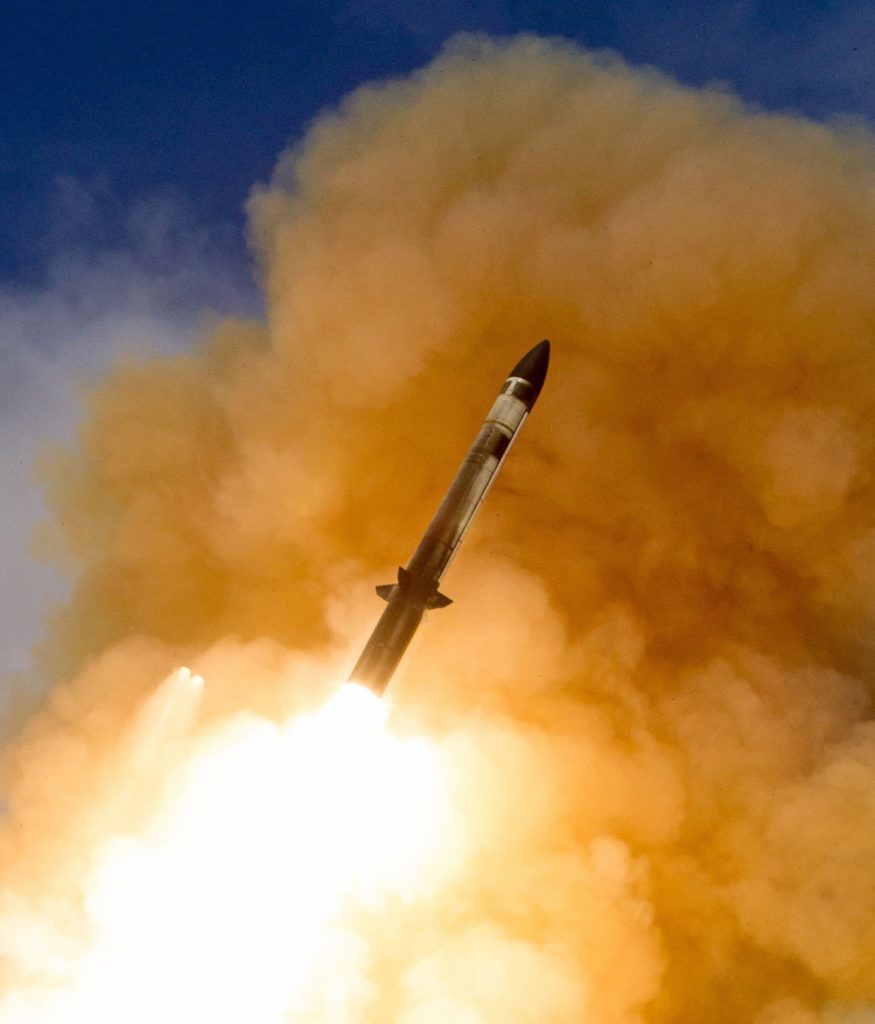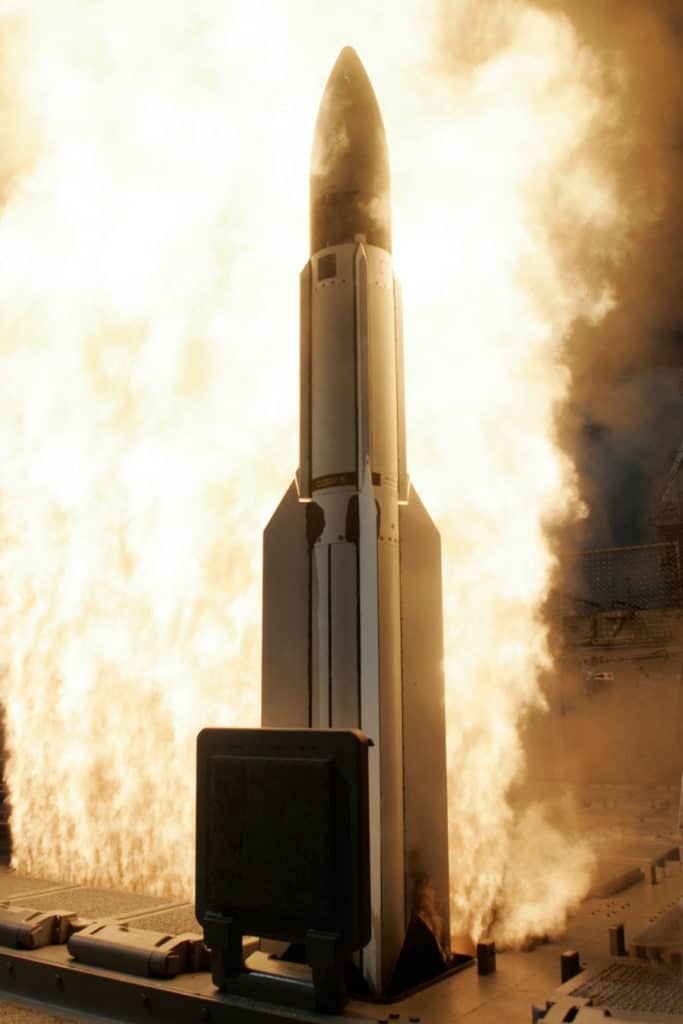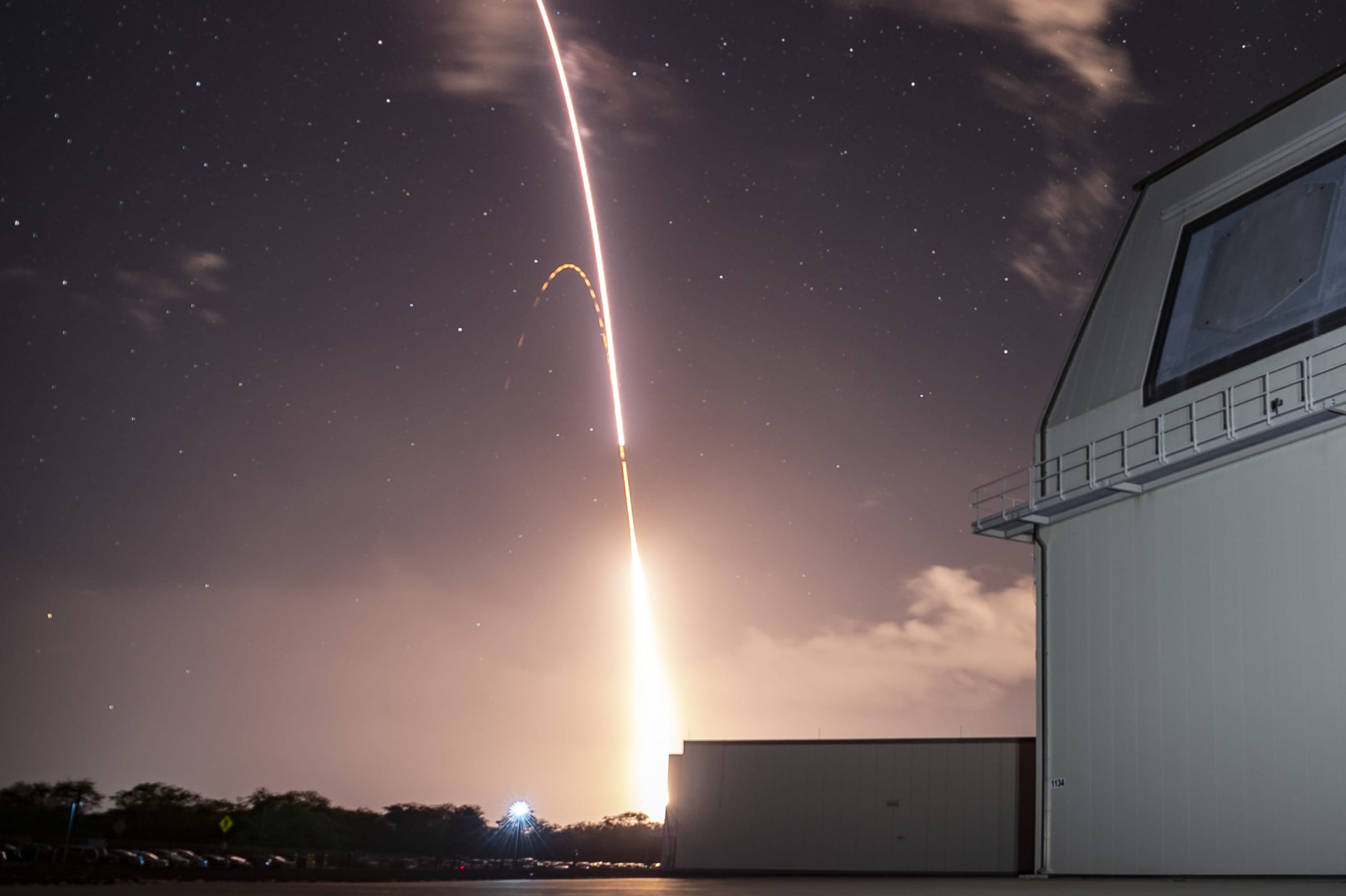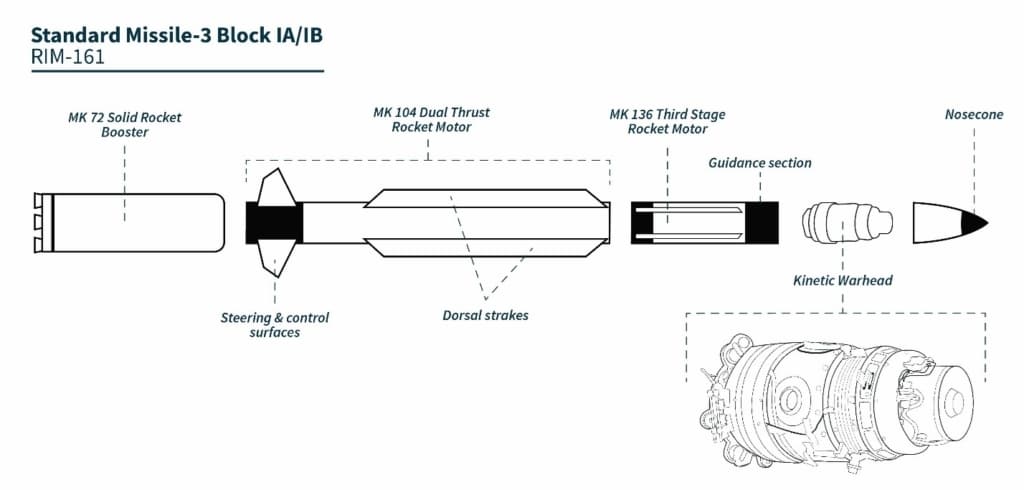The Standard Missile-3 (SM-3) is an exo-atmospheric missile defense interceptor used for theater ballistic missile defense. Part of the the Aegis Weapon System, it uses a hit-to-kill kinetic kill vehicle to intercept ballistic missiles during the midcourse of their flight path. SM-3s are unique due to being the only Standard Missile designed to operate in the vacuum of space. The first Aegis BMD ships fielded SM-3 Block I interceptors in 2005, and the first Block IA interceptors deployed in 2006.1 All of the current SM-3 variants fire from Mk 41 Vertical Launching System (VLS) cells on both Aegis-equipped ships and Aegis Ashore sites.

Standard Missile-3 (SM-3)
- Originated From
- United States
- Possessed By
- United States, Japan
- Basing
- Ship- and ground-launched
- Class
- Surface-to-air missile
- Length
- 6.55 m
- Variants
- Block IA (RIM-11B); Block IB (RIM-161D); Block IB Threat Upgrade (TU)
- Diameter
- IA and IIB, 0.34 m; IIA, 0.54 m
- Range
- IA and IB, 700 km; IIA, 2,500 km
- Guidance
- Inertial, Command, Midcourse GPS
- Propulsion
- Solid-fuel
- Speed
- IA and IB, 3.0 km/s; IIA, 4.5 km/s
- Status
- Operational
- In Service
- Block IA, 2005; IB, 2014; IIA, 2019
- Manuever / Divert Control
- Tail-controlled / SDACS (KW)
- Launcher
- Mk 41 VLS



SM-3 Development
The SM-3 interceptor was developed incrementally, accompanied by a robust testing regime. The Navy has conducted more than 45 SM-3 intercept tests since 2002. Its lineage reaches far back: the SM-3 airframe is an evolution of the SM-2 Block IV, a product of the Navy Theater Wide program conducted during the 1990s and kill vehicle miniaturization technology began during the Strategic Defense Initiative.
The basis for the SM-3’s hit-to-kill technology drew its roots to technology explored during the Strategic Defense Initiative. Among the most important of these was the Lightweight Exo-Atmospheric Projectile program (LEAP). Initiated in 1985, the LEAP program drew on a prior U.S. Army research program to develop a hit-to-kill projectile for rail guns. Weighing a mere 13 pounds, the LEAP kill vehicle prototype employed an infrared sensor, dense electronics, and a compact set of divert thrusters. It completed its first free-flight hover test in 1991.2 In addition to the SM-3, LEAP’s technology was also vital to the development of the Exoatmospheric Kill Vehicle (EKV), the interceptor component of the Ground-based Interceptor.3
In 1992, BMDO and the Navy took over LEAP development and began a series of flight and intercept tests under the auspices of the Terrier LEAP Demonstration Program.4 The system would feature multiple guidance and homing systems across inertial, satellite, and infrared guidance and homing systems across its second, third and fourth stages.5 Based on the Terrier version of the SM-2ER Blk II, it retained the interceptor’s Mk 70 solid rocket booster and aerodynamic Mk 30 sustainer second stage.6 The Terrier LEAP prototype also included a newly designed, GPS-guided third stage called the Advanced Solid Axial Stage (ASAS). The ASAS propelled the LEAP kill vehicle the final leg out of the atmosphere and into space.7 This early prototype established the basic form of what we now recognize as the SM-3.
There are four basic variants of the SM-3 currently in service or under development: the SM-3 Block IA, IB, IB Threat Upgrade (TU), and the IIA. All are fired using the Mark 41 VLS.
Specifications
SM-3 missiles have three-stage missiles, sharing the first two stages of the SM-2 Block IV (Mk 72 Booster and Mark 104 Dual Thrust Rocket Motor) along with a third stage solid-propellant rocket (Mk 136 Third Stage Rocket Motor) to increase velocity at atmospheric exit. The kill vehicle for the SM-3 is derived from the Lightweight Exo-Atmospheric Projectile or LEAP. It combines a kinetic warhead with a longwave infrared seeker for target discrimination as well as a divert and attitude control thruster to maneuver the kill vehicle in response to the information collected by the seeker.8
SM-3 Block IA and IB
The SM-3 IA and IB respectively represent the first and second generation of exoatmospheric sea-based ballistic missile defense interceptors. They are designed to destroy short- to intermediate-range ballistic missiles during their midcourse phase.9 The Missile Defense Agency has acquired 150 SM-3 IA and 182 SM-3 IB interceptors, which are deployed across the Navy’s Aegis BMD-capable cruisers, destroyers, and Aegis Ashore sites.
The Block IA and IB interceptors both have a 21-inch-diameter booster stage and then a 13.5-inch diameter across the rest of their length.10

The Block IB interceptor improves upon the seeker technology on the Block IA with a two-color version and an advanced signal processor to more accurately discriminate between threatening and non-threatening objects.11 The IB also incorporates an improved Throttling Divert and Attitude Control System (TDACS), which gives the kill vehicle better ability to maneuver as it closes in on the target.12
The Block IB finished testing and was declared operationally ready after FTM-22 in 2013. MDA began procurement in FY 2014.13 The Block IB interceptor is the primary interceptor for the Aegis Ashore site in Romania, fielded as part of Phase 2 of the European Phased Adaptive Approach.
In response to observed changes in ballistic missile threats, the US. Navy and MDA in 2015, tested a modified version of the SM-3 IB, the SM-3 Block IB “Threat Update” (TU). Equipped with new discrimination software, algorithms, the SM-3 IB TU is able to tackle “more complicated, more lethal targets.”14 MDA conducted development flight tests of the SM-3 IB TU in FY 2016, and in October 2017, the Navy successfully intercepted an MRBM target with a production-representative SM-3 IB TU during a fleet exercise.15 This variant continued to be launched in Aegis system tests through the end of FY2018, including a successful September 2018 test carried out by the Japanese destroyer JS Atago (DDG 177).16
SM-3 Block IIA
The SM-3 Block IIA missile represents the next generation of Aegis BMD interceptor and is the product of a co-development agreement between the United States and Japan. The technology for SM-3 IIA builds on a 1999 cooperative agreement with Japan on missile defense, which came as a response to the Taepodong-1 overflight of Japan in 1998.17 These efforts coalesced into the SM-3 IIA development program starting in 2006, aiming to produce an interceptor capable of wide area defense against intermediate-range missiles, a primary security concern for Japan. As part of the cooperative development, Japan took on primary responsibility for developing the new nosecone and the second and third stage motor.18 A key part of the EPAA Phase III, the Aegis Ashore site in Poland will likely be among the first Aegis platforms to receive the IIA. The interceptor’s greater speed and range is a component critical to EPAA achieving full defended coverage of European NATO territory.
In 2018, MDA began procurement of SM-3 IIA interceptors, with deployment predicted for FY2019. However, testing issues delayed some of the initial production.19
Unlike earlier versions, the Block IIA features a uniform 21-inch width along its body, creating room for additional propulsion in its second stage and a larger kill vehicle that can carry more divert fuel. The larger second stage allows the missile to achieve greater exit velocities, increasing its defended area and giving it a capability against ICBM-class threats. The increased divert capability further enhances the capability to defend against more complex and faster threats, as the SM-3 Block IIA kill vehicle can maneuver more effectively to deal with higher closing speeds and potentially counter maneuvering warheads.
The major upgrade to the SM-3 IIA interceptor guidance systems is the new kill vehicle, which features a new SDACS, upgraded communications, and an improved two-color seeker. In addition to this sensor, it also employs a light-sensitive electro-optical sensor. According to MDA, the Block IIA seeker has more than double the sensitivity and more than three times the divert capability of the Block IB.20 The upgraded sensitivity, when combined with the new seeker’s ability to perform “reach-back” communications to the ground, allows the IIA interceptors to act as an additional sensor in the threat cloud, aiding other interceptors in discrimination.
ICBM Underlay Capability
The additional propulsion and seeker sensitivity and divert capability of the SM-3 IIA enables it to intercept ICBM-class missiles. MDA slides going back to 2008 have suggested that the IIA could have some capability against ICBM threats, a finding supported by a 2012 National Academies of Science report on missile defense.21
On November 16, 2020, the MDA and U.S. Navy conducted a successful test intercept of the Standard Missile-3 Block IIA against an ICBM-class target. Designated FTM-44 “Stellar Lance,” the event satisfies a Congressional mandate to test the SM-3 IIA against an ICBM by the end of 2020.22
SM-3 Block IIB
The Pentagon cancelled plans for an additional Block IIB version in 2013.23 The Block IIB interceptor would have consisted of a wider booster rocket, requiring modifications to the existing Aegis launcher systems, to create even higher burnout velocities to potentially intercept intercontinental-range ballistic missiles. This interceptor was intended for deployment in Phase 4 of the European Phased Adaptive Approach, but was cancelled in March 2013. The IIB program was then eliminate in favor of research and development into the Common Kill Vehicle (CKV), a project to develop technologies for both Standard Missiles and Ground-based Interceptors. 24
Inventory
SM-3 interceptors are high demand, low density assets. As of 2018, MDA had only acquired around 336 SM-3s of any type. The MDA and the Navy have expended 47 of these rounds in tests, and 24 are emplaced at the Aegis Ashore site in Deveselu, Romania. Most of the remaining 265 are assigned to the Navy’s BMD-capable ships, which are themselves spread around the globe across four U.S. combatant commands.
Anti-Satellite Role
The 2008 Operation Burnt Frost intercept of a non-functional reconnaissance satellite demonstrated that SM-3 interceptors could be used to conduct anti-satellite missions if required. Launched by the USS Lake Erie (CG-70), this marked the only operational use of an SM-3.
The expanded range of the Block IIA interceptors would allow them to reach even higher orbit satellites should they be used for such a mission. Concerns about the amount of debris in low earth orbit created by a kinetic collision with a satellite would limit the utility of this application, however, as it could also affect the functioning of U.S. satellites.25
Footnotes
- “Aegis Ballistic Missile Defense Interceptors (SM-3, SM-2 Block IV, and SM-6),” mostlymissiledefense.com, May 2, 2012. http://mostlymissiledefense.com/2013/05/02/aegis-ballistic-missile-defense-interceptors-sm-3-sm-2-block-iv-and-sm-6-may-2-2012/.
- P. Barker, B. Kelley, and A. Avetissian, “Lightweight Exo-Atmospheric Projectile (LEAP) Space Flight Test, June 1992, Performance Validation” (paper presentation, AIAA SDIO Interceptor Technology Conference, Albuquerque, NM, June 6-9, 1993), passim, http://www.dtic.mil/dtic/tr/fulltext/u2/a344793.pdf.
- James D. Syring, “Homeland Defense” (speech, 2014 Space and Missile Defense Symposium, Huntsville, AL, August 13, 2014).
- No direct connection with the Terrier missile.
- Ralph E. Hawes and James R. Whalen, “The STANDARD Missile/AEGIS Story,” Naval Engineers Journal, VOL # (2009): 150.
- Ralph E. Hawes and James R. Whalen, “The STANDARD Missile/AEGIS Story,” Naval Engineers Journal, VOL # (2009): 150.
- K. E. Olsen, J. J. Walsh, and E. L. Thomas, “Navy Terrier LEAP Third-Stage Propulsion” (paper presentation, AIAA Missile Sciences Conference, Monterey, California, November 7–9, 1994), passim,http://www.dtic.mil/dtic/tr/fulltext/u2/a288615.pdf
- Mark A. Landis, “Overview of the Fire Control Loop Process for Aegis LEAP Intercept,” John’s Hopkins Applied Technical Digest 22 (4), pp. 436-446, http://www.jhuapl.edu/techdigest/TD/td2204/Landis.pdf.
- “Aegis Ballistic Missile Defense,” Missile Defense Agency, accessed December 4, 2018, https://www.mda.mil/system/aegis_bmd.html.
- Ronald O’Rourke, Navy Aegis Ballistic Missile Defense (BMD) Program: Background and Issues for Congress (Washington D.C.: Congressional Research Service), May 12, 2017, https://www.fas.org/sgp/crs/weapons/RL33745.pdf.
- mostlymissiledefense, 2012.
- “Raytheon and Aerojet Demonstrate SM-3 Throttling Divert and Attitude Control System,” PRNewswire, August 15, 2006, http://www.prnewswire.com/news-releases/raytheon-and-aerojet-demonstrate-sm-3-throttling-divert-and-attitude-control-system-56176257.html.
- James D. Syring, “Unclassified Statement of Vice Admiral J.D. Syring, USN Director, Missile Defense Agency Before the Senate Appropriations Committee Subcommittee on Defense,” March 18, 2015, http://www.mda.mil/global/documents/pdf/ps_syring_031815_sacd.pdf.
- “Standard Missile Completes First Intercept Test From Aegis Ashore Test Site,” Missile Defense Agency, December 10, 2015, https://www.mda.mil/news/15news0011.html; “Raytheon to upgrade SM-3 interceptor software,” Arizona Daily Star, March 11, 2015, accessed December 4, 2018, https://tucson.com/business/local/raytheon-to-upgrade-sm–interceptor-software/article_8d4d4c16-c82d-11e4-a1cf-6bdbdfd7303a.html.
- Director, Operational Test and Evaluation, “Ballistic Missile Defense Systems (BMDS),” in FY 2016 Annual Report (Washington, DC: U.S. Department of Defense, 2016), 292, http://www.dote.osd.mil/pub/reports/fy2017/pdf/bmds/2017aegisbmd.pdf.
- “Japan Missile Defense Flight Test Successful Through Intercept,” Missile Defense Agency, news release, September 12, 2018, https://www.mda.mil/news/18news0005.html.
- Richard P. Cronin, Japan-U.S. Cooperation on Ballistic Missile Defense: Issues and Prospects, CRS Report No. FL31337 (Washington DC: Congressional Research Service, March 19, 2002): 10, https://www.everycrsreport.com/files/20020319_RL31337_822a160b7c1a7e8f47606dfa4611eea6c8f7e268.pdf.
- Ministry of Defense, Japan, “Japan’s BMD,” (September 2008) https://www.sldinfo.com/wp-content/uploads/2009/12/Japan-MOD-BMD-report-20081.pdf, 17; “AEGIS SM-3 Block IIA Co-Development,” Missile Defense Agency, RDT&E Budget Item Justification, February 2015, https://www.globalsecurity.org/military/library/budget/fy2016/dod-peds/0604881c_4_pb_2016.pdf.
- Director, Operational Test and Evaluation, “Aegis Ballistic Missile Defense (Aegis BMD),” in FY 2017 Annual Report (Washington, DC: U.S. Department of Defense, 2017), 291, http://www.dote.osd.mil/pub/reports/fy2017/pdf/bmds/2017aegisbmd.pdf.
- MDA, Fiscal Year 2019 Budget Estimates: Missile Defense Agency (MDA) (Washington, DC: MDA, 2013), 663, https://comptroller.defense.gov/Portals/45/Documents/defbudget/fy2019/budget_justification/pdfs/03_RDT_and_E/U_RDTE_MasterJustificationBook_Missile_Defense_Agency_PB_2019_1.pdf.
- Missile Defense Agency, “Aegis Ballistic Missile Defense: Status, Integration and Interoperability,” May 6, 2008; Committee on an Assessment of Concepts and Systems for U.S. Boost-Phase Missile Defense in Comparison to Other Alternatives, Division on Engineering and Physical Science, National Research Council, Making Sense of Ballistic Missile Defense: An Assessment of Concepts and Systems for U.S. Boost-Phase Missile Defense in Comparison to Other Alternatives (Washington, DC: National Academies Press, 2012), 27.
- Shaan Shaikh, “US Completes SM-3 IIA Against ICBM-class Target,” Missile Threat, Center for Strategic and International Studies, November 17, 2020, last modified November 17, 2020, https://missilethreat.csis.org/us-completes-sm-3-iia-against-icbm-class-target/.
- David M. Herszenhorn and Michael R. Gordon, “U.S. Cancels Part of Missile Defense That Russia Opposed,” New York Times, March 16, 2013, http://www.nytimes.com/2013/03/17/world/europe/with-eye-on-north-korea-us-cancels-missile-defense-russia-opposed.html.
- James D. Syring, “Ballistic Missile Defense Overview Slides from Presentation To: 16th Annual Space & Missile Defense Symposium,” August 14, 2013, http://www.defenseinnovationmarketplace.mil/resources/MDASpaceMissileBrief2013.pdf.
- Eric Heginbotham, The U.S.-China Military Scorecard: Forces, Geography, and the Evolving Balance of Power 1996-2017, (Santa Monica, California: RAND Corporation, 2015), http://www.rand.org/content/dam/rand/pubs/research_reports/RR300/RR392/RAND_RR392.pdf.